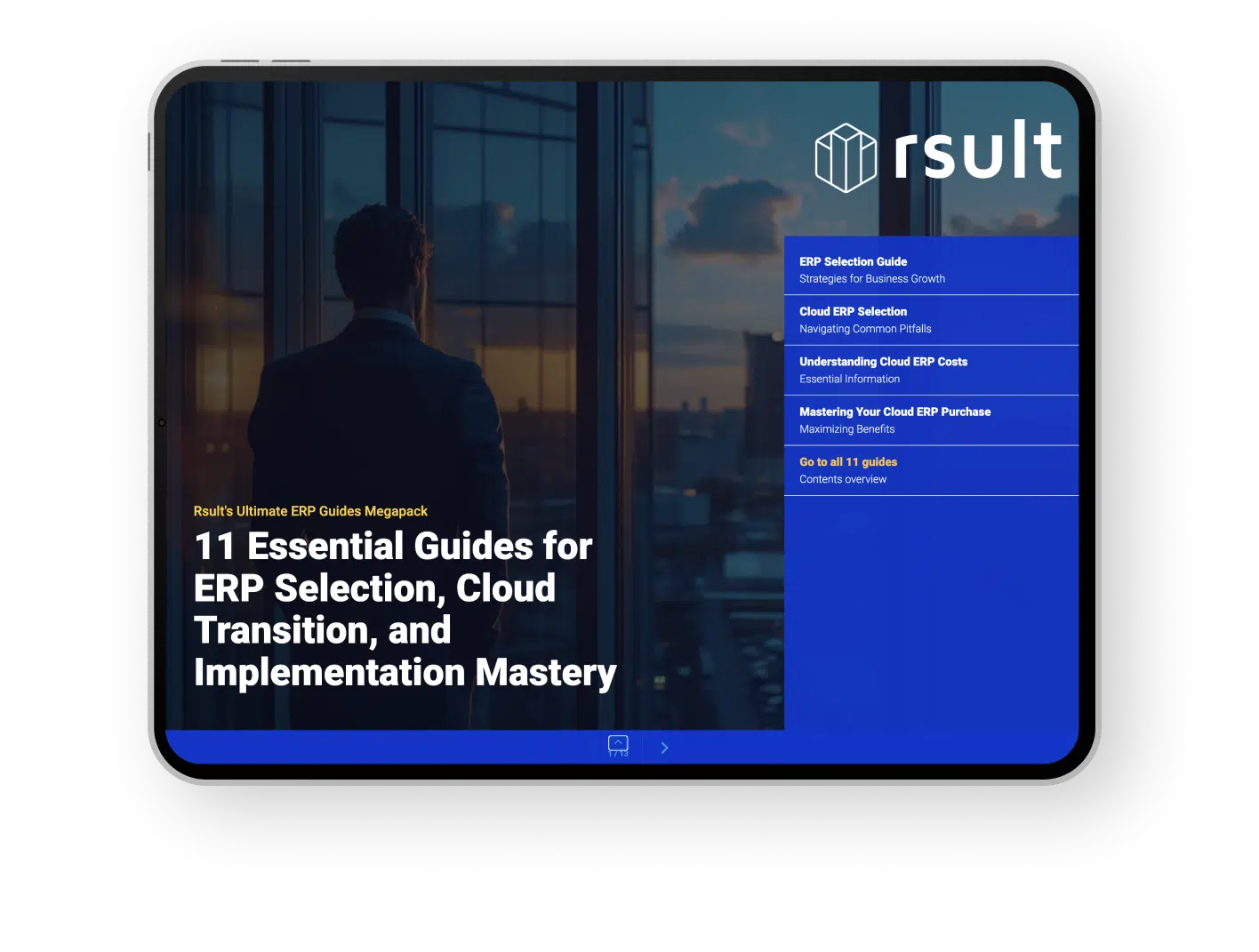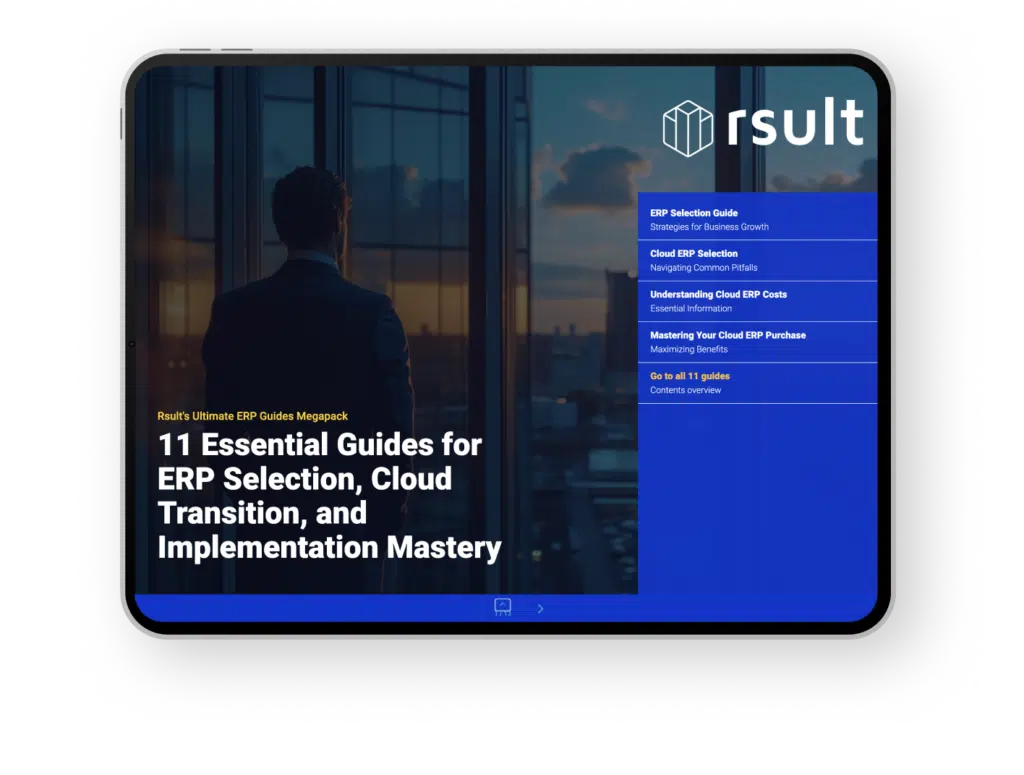As the SaaS landscape continues to flourish, your business might seek a robust backbone to manage the accelerating demands and complex subscription models innate to this field. Enter ERP for SaaS companies—a comprehensive, cloud-based ERP solution crafted to align with the particular needs of your dynamic industry. Implementing an ERP isn’t just about bringing efficiency into your day-to-day operations; it’s a strategic move towards scalability and adaptability in a fast-paced market. With well-integrated SaaS ERP software, you gain real-time insights, automate core functions, and manage customer relationships and subscriptions with finesse. The journey of a SaaS ERP implementation propels your business forward, facilitating a transition to automated excellence and strategic clarity across all facets of your enterprise.
Key Takeaways
- SaaS ERP software offers a specialized suite of tools for automating and streamlining your SaaS business operations.
- A successful ERP implementation empowers scalability and rapid adaptation to evolving market demands.
- Innovative ERP solutions for SaaS companies optimize resource allocation and customer satisfaction.
- Real-time analytics provided by a cloud-based ERP guide informed decision-making.
- Effective management of billing and subscription models is a cornerstone of a robust SaaS ERP system.
- Strategically embracing ERP can drive your SaaS business to achieve substantial long-term benefits.
Understanding ERP for SaaS Companies
As a SaaS company, you understand the importance of agility and the ability to quickly adapt to market changes. In this context, your choice of enterprise resource planning (ERP) systems can make a considerable difference. Let’s delve deeper into what SaaS ERP software is, how it has evolved, and the key components that make it indispensable for businesses like yours.
Defining SaaS ERP Software
At its core, SaaS ERP software is a comprehensive, cloud-based ERP solution tailored for the unique demands of SaaS businesses. Unlike traditional systems, it’s delivered as a service, with the flexibility of a monthly subscription, typically based on the number of users. This accessibility makes ERP integration for SaaS companies not just convenient but also cost-effective, with the system’s operations managed entirely by the vendor. As a result, you get to focus on your core business activities, with the heavy lifting of managing software left to the experts.
The Evolution of ERP Solutions in the SaaS Industry
Over time, cloud-based ERP systems have revolutionized the SaaS industry. Adapting to the business model of subscription-based services, ERP for SaaS companies has grown from a novel idea to a necessary tool. It’s empowered organizations to align their operations with the speed and scalability that the SaaS environment demands, especially as the shift towards subscription models has become the norm. The evolution reflects a symbiosis; as SaaS grows, so does the functionality and efficacy of ERP solutions that cater to this sector.
Key Components of SaaS ERP Platforms
The backbone of effective SaaS ERP platforms is their integrated components, designed to bring all your core operations under one roof. These typically include:
| Component | Function | Benefits for SaaS Companies |
|---|---|---|
| Customer Relationship Management (CRM) | Manage and analyze customer interactions and data | Improves customer satisfaction and retention |
| Financial Management | Track and manage your business’s financial health | Ensures accurate financial reporting and compliance |
| Subscription and Billing | Automate billing cycles and manage subscriptions | Streamlines revenue streams and reduces errors |
| Project Management | Plan, monitor, and manage projects effectively | Increases efficiency and collaboration across teams |
Each component is integral to the other, creating a synergistic system that integrates and automates your business operations. When you have a robust cloud-based ERP, you’re equipped with the tools to accelerate efficiency and growth.
Transforming Business Operations with ERP Integration
As a SaaS company, you’re well aware of the fast-paced environment in which you operate, where efficiency and integration are not just desirable, they’re necessary. Integrating an ERP system into your core operations can be the game-changer your company requires. This robust solution is pivotal for improving overall business functionality, enhancing customer satisfaction, and ensuring your financials are always in crystal-clear focus.
Streamlining Customer Management Processes
Imagine having all your customer interactions, data, and history in one centralized place. By taking advantage of ERP integration for SaaS companies, you can automate these customer management processes, freeing up valuable time and resources. This level of automation leads to a significant leap in service quality, fostering stronger relationships with your customers and ultimately enhancing retention rates.
Centralizing Financial Operations for Clarity
Within a unified ERP system, your financial operations are transformed. Complex billing scenarios that once caused headaches are now seamlessly managed. The ERP benefits for SaaS businesses are particularly evident through centralized accounting features which yield clear, accurate financial reporting. It’s a transparency that not only benefits team members but provides the financial clarity that stakeholders appreciate.
Efficient Project Management and Execution
With ERP systems, project management becomes a breeze. You can plan, monitor, and execute projects with a newfound efficiency that only automation can provide. This sort of operational efficiency amplifies your team’s ability to manage the customer lifecycle and improves subscription management, laying the groundwork for sustained business growth.
Below is a table that exemplifies how ERP integration impacts various aspects of SaaS business operations:
| Business Area | Before ERP Integration | After ERP Integration |
|---|---|---|
| Customer Management | Manual data entry and tracking | Automated processes and centralized data |
| Financial Reporting | Disparate systems and potential errors | Unified financial data and accurate reporting |
| Project Execution | Diffused responsibilities and oversight | Streamlined workflows and real-time monitoring |
| Decision-Making | Based on fragmented data | Data-driven with actionable insights |
As you can see, the transition to an integrated ERP system offers not just incremental, but transformative benefits. While embracing ERP solutions may seem daunting at first due to the perceived complexity of their integration, with the right strategy, it can serve as the backbone for a SaaS business, poised to thrive in a competitive market.
Automating Billing and Revenue Management
As you delve deeper into the capabilities of SaaS ERP implementation, you’ll see that one of the primary benefits lies in its ability to automate critical financial processes. Modern ERP solutions are adept at handling intricate, recurring revenue models that are typical in SaaS businesses.
Consider the element of automated billing. With this feature, the ERP software takes charge, sending out invoices and processing payments on a regular, predetermined schedule, effectively eliminating the risk of human error and freeing up your team to focus on other strategic tasks. This type of billing automation is crucial for consistently managing the lifecycle of a SaaS subscription model and maintaining steady cash flow.
When it comes to revenue management, SaaS ERP systems are equally effective. They offer sophisticated modules designed to recognize revenue according to international accounting standards. This part of the ERP plays a crucial role by ensuring that your financial reporting remains accurate and transparent, keeping you on the right side of compliance.
- Reduction of manual data entry and associated errors
- Efficient management of billing cycles, regardless of complexity
- Improved accuracy in revenue recognition and financial reporting
- Assurance of compliance with evolving financial standards
The leap to a SaaS ERP platform brings about significant improvements in financial operations, catering to all billing and revenue-related activities in an organized and legally compliant manner. By embracing an integrated approach to your company’s finances, you rest assured that the financial backbone of your business operations runs smoothly and efficiently.
ERP Benefits for SaaS Businesses: A Closer Look
As a leader in a SaaS business, you’re no doubt always seeking ways to push efficiency and foster growth. Whether your company is in its early stages or looking to expand, understanding the advantages of integrating an Enterprise Resource Planning system can be a game-changer. Let’s explore why so many SaaS businesses are turning to ERP solutions to streamline operations, enhance data analysis, and accelerate scalability.
Enhancing Operational Efficiency
Efficiency is the lifeblood of any thriving SaaS organization. By implementing a SaaS ERP platform, you empower your team with tools designed to reduce manual work, automate business processes, and consolidate your operational needs into one comprehensive system. This integrated approach minimizes the likelihood of errors and allows for quicker turnaround times across various departments, from sales to customer support.
Making Data-Driven Decisions with Analytics
Harnessing the power of data is critical in making informed decisions for your SaaS business. ERP systems are not just repositories of information; they’re dynamic tools that offer analytics and reporting capabilities. By delivering real-time insights, an ERP platform helps you understand customer behaviors, financial trends, and operational performance, guiding strategic decisions that can lead to improved outcomes and increased profit margins.
Ensuring Business Scalability and Flexibility
SaaS businesses are inherently dynamic, with the need to respond to rapid market changes efficiently. SaaS ERP platforms are designed with scalability in mind, meaning they grow with your business. When your operational capacity needs to expand, the ERP system adapts swiftly, allowing you to embrace market opportunities without being hampered by your back-end systems.
| Operational Area | Challenges | ERP Solutions | Business Benefits |
|---|---|---|---|
| Billing and Subscription Management | Complexity in tracking recurring revenue | Automated billing and subscription workflows | Accurate revenue forecasts, compliance with accounting standards |
| Customer Relationship Management | Siloed customer data, manual processes | Integrated CRM platform within ERP | Unified customer view, improved customer satisfaction |
| Financial Reporting | Time-consuming report generation | Real-time financial analytics and reporting | Quick access to financial insights, data-driven decision making |
| Project Management | Disjointed project tracking | Centralized project management tools | Streamlined workflows, improved resource allocation |
Ultimately, embracing the benefits of ERP for your SaaS business not only primes you for present-day efficiency but sets you on a solid path for future growth. Understanding these systems’ role in scalability, data-driven insights, and operational efficiency can be the difference between leading the pack and falling behind.
Challenges in ERP Implementation and Customization
Embarking on SaaS ERP implementation is a strategic move that can propel a SaaS company ahead, but the path isn’t without its hurdles. Customizing an ERP solution effectively requires precise alignment with your unique business workflows, presenting a sizable challenge due to the diversity of processes within different SaaS organizations. Aligning the software with your business goals is critical for maximizing the benefits of ERP integration for SaaS companies.
One substantial roadblock many SaaS companies face is user adoption. People are creatures of habit, and shifting to a new system can be met with resistance. Foreseeing this, it becomes essential to employ not only strategic training sessions but also to foster an environment that underscores the benefits and improvements the new ERP system brings. Remember, the successful adoption of any ERP hinges on the users working with it daily. To surmount these stumbling blocks, let’s break down the strategic steps you can take:
- Needs Analysis: Begin by pinpointing your business’s unique needs. What does your SaaS company require that generic businesses might not?
- Vendor Selection: Choose a vendor experienced in the SaaS landscape. They are more likely to understand your specific demands for ERP customization for SaaS.
- Training and Support: Deploy comprehensive training programs and support structures. This helps in easing the transition and encourages user adoption.
Integration complexity adds another dimension to the challenge. Integrating the ERP with existing SaaS platforms could entail a significant degree of refinement to ensure all parts of your business communicate seamlessly. The below table elucidates common integration requirements versus potential customization needs to draw a contrast in implementation efforts:
| Integration Requirement | Customization Need |
|---|---|
| Data Synchronization between ERP and SaaS platforms | Custom workflows for unique subscription models |
| Real-time access to financials and customer data | Specific reporting features for SaaS metrics |
| User interface that aligns with existing tools | Modification of standard ERP features to support SaaS operations |
| APIs for third-party application integration | Personalized dashboards tailored for different user roles |
In the end, your journey towards implementing and customizing an ERP system should be both strategic and methodical. Considering these challenges upfront and preparing to address them with a thoughtful approach will position you for a successful SaaS ERP implementation. Remember, effective ERP integration and customization are not just about the technology; they’re about enhancing your workflows, empowering your team, and achieving business growth.
Optimizing Customer Relationships Through ERP Tools
As your SaaS business grows, staying on top of customer relationships becomes a formidable challenge. Fortunately, incorporating ERP tools with robust CRM capabilities can be a game-changer. Offering a centralized platform, a CRM within ERP is more than just a contact management system—it’s a strategic partner in improving customer service management and fostering enduring customer loyalty.
Improving Customer Interactions
Every interaction with your customers is an opportunity to strengthen your relationship. With CRM within ERP, you can ensure that these encounters are as effective and engaging as possible. These systems provide your customer service teams with immediate access to comprehensive customer histories, preferences, and past communications, empowering them to provide personalized and informed support that customers appreciate.
Unpacking the CRM Features within ERP
Diving deeper into the benefits, we find that the CRM within ERP harbors an array of features designed to enhance customer engagement. Let’s outline some of these features:
| Feature | Benefit | Impact on Customer Relationship |
|---|---|---|
| Contact Management | Stores detailed customer information in a central repository. | Enhances personalization and responsiveness in customer interactions. |
| Interaction Tracking | Logs every interaction with customers across multiple channels. | Provides context for future conversations and service continuity. |
| Sales Pipeline Management | Gives insight into each stage of the sales process. | Enables targeted follow-ups and timely communications. |
| Service Ticket Management | Streamlines issue reporting and resolution process. | Improves customer service management and satisfaction rates. |
| Marketing Automation | Automates repetitive tasks for marketing campaigns. | Delivers relevant content to customers, improving engagement. |
By leveraging these features, your SaaS company can go beyond merely improving customer relationships to actually redefining them. You’ll transform customer service from a cost center into a valuable asset that drives loyalty, repeat business, and referrals.
Confronting the Cost-Benefit Analysis of ERP Adoption
When you’re considering incorporating an ERP system within your SaaS business, diving into a cost-benefit analysis is imperative. The initial outlay may seem significant, but the long-term ERP benefits for SaaS businesses—like operational efficiency and improved customer management—can lead to a compelling return on investment (ROI). Let’s break down the essential factors to consider in an ERP cost analysis and how it influences the SaaS ERP implementation ROI.
- Initial and Ongoing Costs: Understanding the upfront expenses such as acquisition, deployment, and initial training is crucial. Equally important is accounting for ongoing costs like subscription fees, upgrades, and support services.
- Cost Saving Potential: Cloud-based ERP models can reduce your expenses on hardware and allow you to benefit from shared maintenance costs. Additionally, consider the savings from improved business processes and automation.
- Intangible Benefits: Beyond the immediate financials, ERP brings intangibles such as better decision-making from real-time analytics and enhanced agility in your operations.
Your detailed ERP cost analysis must balance the initial investment against these tangible and intangible returns. Below is a summarized table that illustrates the potential financial implications of adopting an ERP system for a SaaS company.
| Cost Factors | Short-Term Impact | Long-Term Benefits |
|---|---|---|
| Initial Implementation | High initial cost | Streamlined processes lead to operational savings |
| Training | Resource investment in training and adoption | Increased user efficiency and productivity |
| Subscription Fee | Recurrent operational cost | Continuous updates and improved software capabilities |
| System Upgrades | Potential disruptions | Staying on the cutting-edge of technology |
| Support Services | Ongoing expense | Ensures system reliability and issue resolution |
| Data Migration | One-time cost and potential operational disruption | Improved data handling and business insight capabilities |
| Hardware Savings | N/A | Reduced expenditure in IT infrastructure |
In conclusion, it’s evident that careful consideration of both direct and indirect costs, weighed against the comprehensive benefits an ERP system delivers, will guide you towards making a financial decision that aligns with your SaaS business’s strategic goals. Keep in mind, the true value of an ERP extends far beyond its price tag, as it unlocks efficiency, scalability, and data-driven innovation that can propel your company forward.
Evaluating ERP Providers for SaaS Companies
When it’s time for your company to select a SaaS ERP system, the array of SaaS ERP providers can appear dizzying. The right ERP vendor selection is more than just choosing a product; it’s about forming a partnership that will propel your business forward. Understanding the specific criteria for selection and the support services offered can make a world of difference for your operation.
Criteria for Selecting the Right SaaS ERP Provider
ERP vendor selection is a critical step in ensuring that your SaaS company acquires a system that fits like a glove. Factors such as industry-specific features, system flexibility, and the provider’s track record in the SaaS environment play a pivotal role. The chosen SaaS ERP providers should align with your operational requirements and strategic objectives to foster an environment of growth and efficiency.
Customization and Integration Support
One size rarely fits all, especially in the fast-paced SaaS domain. The SaaS ERP system you decide on must offer robust customization capabilities and smooth integration opportunities with your existing platforms. ERP support services should extend beyond the initial setup, guaranteeing that any subsequent updates, custom modules or integrations are just as seamless and impactful.
Training and Ongoing User Support Services
The real work begins post-implementation. The leading SaaS ERP providers understand that training and ongoing user support services are vital for you to leverage all functionalities of your new ERP system. A reliable provider will not only equip your team with the necessary knowledge but also provide a strong support network for continuous learning and improvement.
| Selection Criteria | Why It’s Important | What to Look For |
|---|---|---|
| Industry Experience | Ensures the provider understands your market nuances and growth dynamics. | History of successful implementations in the SaaS industry. |
| Customization Capability | Allows the ERP to adapt to your specific business processes and needs. | Flexible architecture that supports tailored functionality. |
| Integration Facility | Enables smooth connection with your current systems, avoiding silos of information. | Open API availability and proven integration track record. |
| Training Provisions | Prepares your team to fully use the system’s capabilities. | Comprehensive initial training and ongoing education programs. |
| Ongoing Support | Provides assistance for technical issues and system improvements. | Accessible and knowledgeable customer service teams. |
Your search for the ideal SaaS ERP providers should be thorough and precise. Focus on vendors who can showcase their ability to enhance your business’s performance through an ERP system designed for the unique challenges and opportunities of the SaaS industry. Remember, the choice you make today will influence your company’s efficiency and success for years to come.
Conclusion
ERP for SaaS companies has proven to be no ordinary umbrella of solutions: it’s your tailor-made suit in the realm of efficiency and growth. Such ERP solutions for SaaS companies cater directly to your unique landscape, providing an arsenal of tools that transform complex, manual processes into streamlined, automated systems. Your move towards implementing a SaaS ERP software might come with initial hesitation due to the customization and integration hurdles, yet the strategic maneuvers involved in these stages unfold into operational finesse and a significant return on investment.
As your company stands in the fast-moving currents of the SaaS industry, the agility offered by reliable ERP platforms ensures that you keep pace with the tides of change. Embracing the right SaaS ERP implementation strategies empowers you to harness real-time analytics and scalability options, resulting in an admirable competitive edge. Remember, success lies not only in selecting sophisticated solutions but also in deploying them adeptly within your operations and making the most out of their features.
Therefore, as you inch closer to your goal of transformation, consider your choice of provider and approach to SaaS ERP implementation as pivotal steps on this journey. The potency of well-executed ERP for SaaS companies cannot be overstated—it aligns with your aspirations to be more than just a participant in the market, shaping you into a leader who thrives on innovation and efficiency. So, are you ready to elevate your business with the right ERP solution?
FAQ
What industry-specific benefits and features do ERP systems offer for SaaS companies?
ERP for SaaS companies provides a cohesive suite of tools to automate core business processes such as customer relationship management (CRM), financial management, subscription and billing management, project management, and analytics. These tools are specifically tailored to the unique requirements of the SaaS industry, offering scalability, efficient resource allocation, and the ability to make data-driven decisions.
What is SaaS ERP software?
SaaS ERP software refers to cloud-based ERP solutions that are accessible online, typically on a subscription basis. This software centralizes business operations, allowing SaaS companies to manage their core processes more efficiently through integrated platforms that automate and streamline workflows.
How has ERP evolved to meet the demands of the SaaS industry?
ERP solutions for SaaS companies have evolved to fit the subscription-based business models by incorporating features like subscription management, recurring billing, and customer lifecycle analytics. These advancements are built with the agility needed in the fast-paced SaaS environment ensuring that companies can keep up with market changes and customer demands.
What are the key components of SaaS ERP platforms?
The key components of SaaS ERP platforms include CRM, financial management, subscription and billing, project management, and analytics tools. These components are designed to integrate seamlessly, providing a real-time, automated overview of all business operations specific to SaaS models.
How does ERP integration transform business operations for SaaS companies?
ERP integration streamlines a SaaS company’s varied processes, from improving customer management and interaction to centralizing financials for better reporting and handling complex billing scenarios. It also enhances efficiency in project management and centralizes data for improved decision-making and operational performance.
How does ERP software automate billing and revenue management for SaaS businesses?
ERP software for SaaS streamlines the recurring revenue models crucial to these businesses through features like automated billing cycles, revenue recognition according to accounting standards, and efficient management of subscriptions. This automation supports the financial stability of SaaS companies while ensuring compliance and accuracy.
In what ways do ERP benefits enhance operational efficiency for SaaS businesses?
ERP benefits for SaaS businesses lie in their ability to enhance operational efficiency by reducing manual efforts, improving accuracy, and enabling quicker and more informed decision-making. Built-in analytics provide real-time insights, while scalable platforms ensure that businesses can adjust and grow effectively.
What are some challenges faced during ERP implementation and customization for SaaS businesses?
SaaS companies may encounter challenges with ERP integration, such as aligning the software with unique business models, customizing the system to meet specific needs, and ensuring employee adoption. Effective implementation requires a thorough needs analysis, careful vendor selection, and comprehensive training and support.
How can ERP tools optimize customer relationships for SaaS companies?
ERP tools maximize customer relationships by streamlining customer interactions and managing data effectively, thus improving the service offered. The CRM features within ERP systems assist in building stronger customer relationships by accurately tracking customer interactions and preferences.
What key criteria should be considered when evaluating ERP providers for SaaS companies?
When selecting an ERP provider for a SaaS company, consider the provider’s experience with SaaS businesses, the level of customization and integration support they offer, and whether they provide comprehensive training and ongoing support services. It’s crucial to choose a provider that can tailor their system to your company’s specific needs and ensure efficient integration and user adoption.






